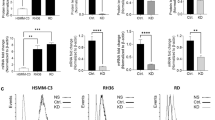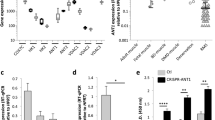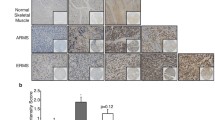Abstract
Purpose
Recent work has highlighted the therapeutic potential of targeting autophagy to modulate cell survival in a variety of diseases including cancer. Recently, we found that the RNA-binding protein Staufen1 (STAU1) is highly expressed in alveolar rhabdomyosarcoma (ARMS) and that this abnormal expression promotes tumorigenesis. Here, we asked whether STAU1 is involved in the regulation of autophagy in ARMS cells.
Methods
We assessed the impact of STAU1 expression modulation in ARMS cell lines (RH30 and RH41), non-transformed skeletal muscle cells (C2C12) and STAU1-transgenic mice using complementary techniques.
Results
We found that STAU1 silencing reduces autophagy in the ARMS cell lines RH30 and RH41, while increasing their apoptosis. Mechanistically, this inhibitory effect was found to be caused by a direct negative impact of STAU1 depletion on the stability of Beclin-1 (BECN1) and ATG16L1 mRNAs, as well as by an indirect inhibition of JNK signaling via increased expression of Dual specificity phosphatase 8 (DUSP8). Pharmacological activation of JNK or expression silencing of DUSP8 was sufficient to restore autophagy in STAU1-depleted cells. By contrast, we found that STAU1 downregulation in non-transformed skeletal muscle cells activates autophagy in a mTOR-dependent manner, without promoting apoptosis. A similar effect was observed in skeletal muscles obtained from STAU1-overexpressing transgenic mice.
Conclusions
Together, our data indicate an effect of STAU1 on autophagy regulation in ARMS cells and its differential role in non-transformed skeletal muscle cells. Our findings suggest a cancer-specific potential of targeting STAU1 for the treatment of ARMS.








Similar content being viewed by others
Data availability
The data supporting the findings are available within the article and its supplementary materials. Additional supporting data and material are available from the corresponding author upon reasonable request.
Code availability
Not applicable.
Abbreviations
- STAU1:
-
Staufen1
- ARMS:
-
Alveolar Rhabdomyosarcoma
- BECN1:
-
Beclin-1
- DUSP8:
-
Dual specificity phosphatase 8
- ERMS:
-
Embryonal Rhabdomyosarcoma
- RBPs:
-
RNA-binding proteins
- GAPDH:
-
3-phosphate dehydrogenase
- LC3:
-
Microtubule-associated protein 1 light chain 3
- BafA1:
-
Bafilomycin A1
- CQ:
-
Chloroquine
- RIP:
-
RNA immunoprecipitation
- p-mTOR:
-
phospho-mTOR
- p-AKT:
-
phospho-AKT
- p-JNK:
-
phospho-JNK
- TA:
-
Tibialis Anterior
- TG:
-
Transgenic
- WT:
-
Wildtype
References
J. Anderson, A. Gordon, A. McManus, J. Shipley, K. Pritchard-Jones, Disruption of imprinted genes at chromosome region 11p15. 5 in paediatric rhabdomyosarcoma. Neoplasia 1, 340–348 (1999)
D.M. Loeb, K. Thornton, O. Shokek, Pediatric soft tissue sarcomas. Surg. Clin. N. Am. 88, 615–627 (2008)
E.R. Rudzinski, J.R. Anderson, Y. Chi, J.M. Gastier-Foster, C. Astbury, F.G. Barr, S.X. Skapek, D.S. Hawkins, B.J. Weigel, A. Pappo, Histology, fusion status, and outcome in metastatic rhabdomyosarcoma: A report from the Children’s Oncology Group. Pediatr. Blood Cancer 64, e26645 (2017)
D. Sarkar, S. Ray, M. Saha, P. Chakrabarti, Alveolar rhabdomyosarcoma with multiple distal metastases. A case report and review of literature. BMJ Case Rep. 2012, 006523 (2012)
S. Hettmer, A.J. Wagers, Muscling in: Uncovering the origins of rhabdomyosarcoma. Nat. Med. 16, 171 (2010)
E.R. Rudzinski, J.R. Anderson, D.S. Hawkins, S.X. Skapek, D.M. Parham, L.A. Teot, The World Health Organization classification of skeletal muscle tumors in pediatric rhabdomyosarcoma: a report from the Children’s Oncology Group. Arch. Pathol. Lab. Med. 139, 1281–1287 (2015)
K. Hollowood, C.D. Fletcher, Rhabdomyosarcoma in adults. Semin. Diagn. Pathol. 11, 47–57 (1994)
J. Hicks, C. Flaitz, Rhabdomyosarcoma of the head and neck in children. Oral Oncol. 38, 450–459 (2002)
C. Keller, D.C. Guttridge, Mechanisms of impaired differentiation in rhabdomyosarcoma. FEBS J. 280, 4323–4334 (2013)
R.J. Davis, C.M. D’Cruz, M.A. Lovell, J.A. Biegel, F.G. Barr, Fusion of PAX7 to FKHR by the variant t(1;13)(p36;q14) translocation in alveolar rhabdomyosarcoma. Cancer Res. 54, 2869–2872 (1994)
N. Galili, R.J. Davis, W.J. Fredericks, S. Mukhopadhyay, F.J. Rauscher, B.S. Emanuel, G. Rovera, F.G. Barr, Fusion of a fork head domain gene to PAX3 in the solid tumour alveolar rhabdomyosarcoma. Nat. Genet. 5, 230 (1993)
P. Eguía-Aguilar, B. López-Martínez, C. Retana-Contreras, M. Perezpeña-Diazconti, Alveolar rhabdomyosarcoma: origin and prognostic implications of molecular findings. Bol. Méd. Hosp. Infant. Méx. 73, 405–410 (2016)
A.D. Marshall, G.C. Grosveld, Alveolar rhabdomyosarcoma–The molecular drivers of PAX3/7-FOXO1-induced tumorigenesis. Skelet. Muscle 2, 1–14 (2012)
C. Perrone, S. Pomella, M. Cassandri, M.R. Braghini, M. Pezzella, F. Locatelli, R. Rota, FAK signaling in rhabdomyosarcoma. Int. J. Mol. Sci. 21, 8422 (2020)
O. Oberlin, A. Rey, E. Lyden, G. Bisogno, M.C. Stevens, W.H. Meyer, M. Carli, J.R. Anderson, Prognostic factors in metastatic rhabdomyosarcomas: results of a pooled analysis from United States and European cooperative groups. J. Clin. Oncol. 26, 2384–2389 (2008)
I. Fierro-Monti, M.B. Mathews, Proteins binding to duplexed RNA: one motif, multiple functions. Trends Biochem. Sci. 25, 241–246 (2000)
S. Hong, RNA binding protein as an emerging therapeutic target for cancer prevention and treatment. J. Cancer. Prev. 22, 203–210 (2017)
B. Pereira, M. Billaud, R. Almeida, RNA-binding proteins in cancer: old players and new actors. Trends Cancer 3, 506–528 (2017)
L. Li, L. Fu, K. Wang, Integrated bioinformatics analysis the function of RNA binding proteins (RBPs) and their prognostic value in breast cancer. Front. Pharmacol. 10, 140 (2019)
T.E.C. Parks, K.A. Marcellus, J. Langill, A. Ravel-Chapuis, J. Michaud, K.N. Cowan, J. Côté, B.J. Jasmin, Novel roles for Staufen1 in embryonal and alveolar rhabdomyosarcoma via c-myc-dependent and-independent events. Sci. Rep. 7, 42342 (2017)
A. Ravel-Chapuis, G. Belanger, R.S. Yadava, M.S. Mahadevan, L. DesGroseillers, J. Cote, B.J. Jasmin, The RNA-binding protein Staufen1 is increased in DM1 skeletal muscle and promotes alternative pre-mRNA splicing. J. Cell Biol. 196, 699–712 (2012)
E. Bondy-Chorney, T.E.C. Parks, A. Ravel-Chapuis, R. Klinck, L. Rocheleau, M. Pelchat, B. Chabot, B.J. Jasmin, J. Côté, Staufen1 regulates multiple alternative splicing events either positively or negatively in DM1 indicating its role as a disease modifier. PLoS Genet. 12, e1005827 (2016)
A. Ravel-Chapuis, T.E. Crawford, M. Blais-Crépeau, G. Bélanger, C.T. Richer, B.J. Jasmin, The RNA-binding protein Staufen1 impairs myogenic differentiation via a c-myc–dependent mechanism. Mol. Biol. Cell 25, 3765–3778 (2014)
A. Ravel-Chapuis, A. Klein Gunnewiek, G. Bélanger, T.E. Crawford Parks, J. Côté, B.J. Jasmin, Staufen1 impairs stress granule formation in skeletal muscle cells from myotonic dystrophy type 1 patients. Mol. Biol. Cell 27, 1728–1739 (2016)
S. Galati, C. Boni, M.C. Gerra, M. Lazzaretti, A. Buschini, Autophagy: a player in response to oxidative stress and DNA damage. Oxid. Med. Cell. Longevity 14, 1–12 (2019)
P. Ravanan, I.F. Srikumar, P. Talwar, Autophagy: The spotlight for cellular stress responses. Life Sci. 188, 53–67 (2017)
D.J. Klionsky, Autophagy. Curr. Biol. 15, R282–R283 (2005)
A. Thorburn, Autophagy and disease. J. Biol. Chem. 293, 5425–5430 (2018)
J. Debnath, Detachment-induced autophagy during anoikis and lumen formation in epithelial acini. Autophagy 4, 351–353 (2008)
C. Fung, R. Lock, S. Gao, E. Salas, J. Debnath, Induction of autophagy during extracellular matrix detachment promotes cell survival. Mol. Biol. Cell 19, 797–806 (2008)
J.M.M. Levy, A. Thorburn, Targeting autophagy during cancer therapy to improve clinical outcomes. Pharmacol. Ther. 131, 130–141 (2011)
A.R. Moghadam, daS. Rosa, C. Simone, E. Samiei, J. Alizadeh, J. Field, P. Kawalec, J. Thliveris, M. Akbari, S. Ghavami, J.W. Gordon, Autophagy modulates temozolomide-induced cell death in alveolar Rhabdomyosarcoma cells. Cell Death Discov. 5, 52 (2018)
J. Zhang, Z. Yang, L. Xie, L. Xu, D. Xu, X. Liu, Statins, autophagy and cancer metastasis. Int. J. Biochem. Cell Biol. 45, 745–752 (2013)
B. Pantic, D. Borgia, S. Giunco, A. Malena, T. Kiyono, S. Salvatori, A. De Rossi, E. Giardina, F. Sangiuolo, E. Pegoraro, Reliable and versatile immortal muscle cell models from healthy and myotonic dystrophy type 1 primary human myoblasts. Exp. Cell Res. 342, 39–51 (2016)
N. Klages, R. Zufferey, D. Trono, A stable system for the high-titer production of multiply attenuated lentiviral vectors. Mol. Ther. 2, 170–176 (2000)
K.J. Livak, T.D. Schmittgen, Analysis of relative gene expression data using real-time quantitative PCR and the 2 – ∆∆CT method. Methods 25, 402–408 (2001)
T.E. Crawford Parks, A. Ravel-Chapuis, E. Bondy-Chorney, J. Renaud, J. Côté, B.J. Jasmin, Muscle-specific expression of the RNA-binding protein Staufen1 induces progressive skeletal muscle atrophy via regulation of phosphatase tensin homolog. Hum. Mol. Genet. 26, 1821–1838 (2017)
E. Ji, C. Kim, H. Kang, S. Ahn, M. Jung, Y. Hong, H. Tak, S. Lee, W. Kim, E.K. Lee, RNA binding protein HuR promotes autophagosome formation by regulating expression of autophagy-related proteins 5, 12, and 16 in human hepatocellular carcinoma cells. Mol. Cell. Biol. 39, e00508–e00518 (2019)
H. Nakatogawa, Regulated degradation: controlling the stability of autophagy gene transcripts. Dev. Cell 34, 132–134 (2015)
J. Viiri, M. Amadio, N. Marchesi, J.M. Hyttinen, N. Kivinen, R. Sironen, K. Rilla, S. Akhtar, A. Provenzani, V.G. D’Agostino, S. Govoni, A. Pascale, H. Agostini, G. Petrovski, A. Salminen, K. Kaarniranta, Autophagy activation clears ELAVL1/HuR-mediated accumulation of SQSTM1/p62 during proteasomal inhibition in human retinal pigment epithelial cells. PLoS One 8, e69563 (2013)
L. Furic, M. Maher-Laporte, L. DesGroseillers, A genome-wide approach identifies distinct but overlapping subsets of cellular mRNAs associated with Staufen1- and Staufen2-containing ribonucleoprotein complexes. RNA 14, 324–335 (2008)
Y. Chen, D.J. Klionsky, The regulation of autophagy - unanswered questions. J. Cell. Sci. 124, 161–170 (2011)
E. Delorme-Axford, D.J. Klionsky, Transcriptional and post-transcriptional regulation of autophagy in the yeast Saccharomyces cerevisiae. J. Biol. Chem. 293, 5396–5403 (2018)
S. Almasi, B.E. Kennedy, M. El-Aghil, A.M. Sterea, S. Gujar, S. Partida-Sanchez, Y. El Hiani, TRPM2 channel-mediated regulation of autophagy maintains mitochondrial function and promotes gastric cancer cell survival via the JNK-signaling pathway. J. Biol. Chem. 293, 3637–3650 (2018)
S. Paul, W. Dansithong, K.P. Figueroa, D.R. Scoles, S.M. Pulst, Staufen1 links RNA stress granules and autophagy in a model of neurodegeneration. Nat. Commun. 9, 3648 (2018)
C.W. Yun, S.H. Lee, The roles of autophagy in cancer. Int. J. Mol. Sci. 19, 3466 (2018)
L.B. Frankel, M. Lubas, A.H. Lund, Emerging connections between RNA and autophagy. Autophagy 13, 3–23 (2017)
P. Torres, O. Ramírez-Núñez, R. Romero-Guevara, G. Barés, A.B. Granado-Serrano, V. Ayala, J. Boada, L. Fontdevila, M. Povedano, D. Sanchís, Cryptic exon splicing function of TARDBP interacts with autophagy in nervous tissue. Autophagy 14, 1398–1403 (2018)
P.S. Acevo-Rodríguez, G. Maldonado, S. Castro-Obregón, G. Hernández, Autophagy regulation by the translation machinery and its implications in cancer. Front. Oncol. 10, 322 (2020)
N. Fujikake, M. Shin, S. Shimizu, Association between autophagy and neurodegenerative diseases. Front. Neurosci. 12, 255 (2018)
E. Dunlop, A. Tee, mTOR and autophagy: a dynamic relationship governed by nutrients and energy. Semin. Cell Dev. Biol. 36, 121–129 (2014)
Y.V. Budovskaya, J.S. Stephan, F. Reggiori, D.J. Klionsky, P.K. Herman, The Ras/cAMP-dependent protein kinase signaling pathway regulates an early step of the autophagy process in Saccharomyces cerevisiae. J. Biol. Chem. 279, 20663–20671 (2004)
N. Lu, X. Li, R. Tan, J. An, Z. Cai, X. Hu, F. Wang, H. Wang, C. Lu, H. Lu, HIF-1α/Beclin1-mediated autophagy is involved in neuroprotection induced by hypoxic preconditioning. J. Mol. Neurosci. 66, 238–250 (2018)
Y. Zhang, P. Chen, H. Hong, L. Wang, Y. Zhou, Y. Lang, JNK pathway mediates curcumin-induced apoptosis and autophagy in osteosarcoma MG63 cells. Exp. Terapeut. Med. 14, 593–599 (2017)
A. Zeke, M. Misheva, A. Reményi, M.A. Bogoyevitch, JNK signaling: regulation and functions based on complex protein-protein partnerships. Microbiol. Mol. Biol. Rev. 80, 793–835 (2016)
C. Tournier, C. Dong, T.K. Turner, S.N. Jones, R.A. Flavell, R.J. Davis, MKK7 is an essential component of the JNK signal transduction pathway activated by proinflammatory cytokines. Genes Dev. 15, 1419–1426 (2001)
K.I. Patterson, T. Brummer, P.M. O’brien, R.J. Daly, Dual-specificity phosphatases: critical regulators with diverse cellular targets. Biochem. J. 418, 475–489 (2009)
Y. Chun, J. Kim, Autophagy: an essential degradation program for cellular homeostasis and life. Cells 7, 278 (2018)
B. Levine, G. Kroemer, Autophagy in the pathogenesis of disease. Cell 132, 27–42 (2008)
L. Min, E. Choy, R.E. Pollock, C. Tu, F. Hornicek, Z. Duan, Autophagy as a potential target for sarcoma treatment. Biochim. Biophys. Acta (BBA)-Rev. Cancer 1868, 40–50 (2017)
Y. Cheng, F. Qiu, T. Ikejima, Molecular mechanisms of oridonin-induced apoptosis and autophagy in murine fibrosarcoma L929 cells. Autophagy 5, 430–431 (2009)
Y. Cheng, F. Qiu, Y. Ye, Z. Guo, S. Tashiro, S. Onodera, T. Ikejima, Autophagy inhibits reactive oxygen species-mediated apoptosis via activating p38‐nuclear factor‐kappa B survival pathways in oridonin‐treated murine fibrosarcoma L929 cells. FEBS J. 276, 1291–1306 (2009)
C. Shen, W. Wang, L. Tao, B. Liu, Z. Yang, H. Tao, Chloroquine blocks the autophagic process in cisplatin-resistant osteosarcoma cells by regulating the expression of p62/SQSTM1. Int. J. Mol. Med. 32, 448–456 (2013)
G. Jiao, W. Guo, T. Ren, Q. Lu, Y. Sun, W. Liang, C. Ren, K. Yang, K. Sun, BMPR2 inhibition induced apoptosis and autophagy via destabilization of XIAP in human chondrosarcoma cells. Cell Death Dis. 5, e1571–e1571 (2014)
S. Reumann, K.L. Shogren, M.J. Yaszemski, A. Maran, Inhibition of autophagy increases 2-methoxyestradiol‐induced cytotoxicity in SW1353 chondrosarcoma cells. J. Cell. Biochem. 117, 751–759 (2016)
X. Zhang, Y. Dong, X. Zeng, X. Liang, X. Li, W. Tao, H. Chen, Y. Jiang, L. Mei, S. Feng, The effect of autophagy inhibitors on drug delivery using biodegradable polymer nanoparticles in cancer treatment. Biomaterials 35, 1932–1943 (2014)
X. Zheng, X. Jin, X. Liu, B. Liu, P. Li, F. Ye, T. Zhao, W. Chen, Q. Li, Inhibition of endoplasmic reticulum stress-induced autophagy promotes the killing effect of X-rays on sarcoma in mice. Biochem. Biophys. Res. Commun. 522, 612–617 (2020)
F. Rapino, M. Jung, S. Fulda, BAG3 induction is required to mitigate proteotoxicity via selective autophagy following inhibition of constitutive protein degradation pathways. Oncogene 33, 1713–1724 (2014)
M. Peron, P. Bonvini, A. Rosolen, Effect of inhibition of the ubiquitin-proteasome system and Hsp90 on growth and survival of rhabdomyosarcoma cells in vitro. BMC Cancer 12, 1–9 (2012)
S. Paul, W. Dansithong, M. Gandelman, T. Zu, L.P. Ranum, K.P. Figueroa, D.R. Scoles, S.M. Pulst, Staufen blocks autophagy in neurodegeneration. bioRxiv (2019). https://doi.org/10.1101/659649
R. Sever, J.S. Brugge, Signal transduction in cancer. Cold Spring Harb Perspect. Med. 5, a006098 (2015)
S. Kumari, A.K. Badana, M. Mohan, G.G. Shailendr, R. Malla, Reactive oxygen species: a key constituent in cancer survival. Biomark. Insights 13, 1–9 (2018)
J. Zhang, X. Wang, V. Vikash, Q. Ye, D. Wu, Y. Liu, W. Dong, ROS and ROS-mediated cellular signaling. Ox. Med. Cell. Longevity 2016, 4350965 (2016)
Q. Wu, W. Wu, B. Fu, L. Shi, X. Wang, K. Kuca, JNK signaling in cancer cell survival. Med. Res. Rev. 39, 2082–2104 (2019)
H. Wang, T. Zhang, W. Sun, Z. Wang, D. Zuo, Z. Zhou, S. Li, J. Xu, F. Yin, Y. Hua, Erianin induces G2/M-phase arrest, apoptosis, and autophagy via the ROS/JNK signaling pathway in human osteosarcoma cells in vitro and in vivo. Cell Death Dis. 7, e2247–e2247 (2016)
L. Harhaji, S. Mijatovic, D. Maksimovic-Ivanic, D. Popadic, A. Isakovic, B. Todorovic-Markovic, V. Trajkovic, Aloe emodin inhibits the cytotoxic action of tumor necrosis factor. Eur. J. Pharmacol. 568, 248–259 (2007)
H. Zhou, T. Shen, C. Shang, Y. Luo, L. Liu, J. Yan, Y. Li, S. Huang, Ciclopirox induces autophagy through reactive oxygen species-mediated activation of JNK signaling pathway. Oncotarget 5, 10140–10150 (2014)
T. Tian, X. Li, J. Zhang, mTOR signaling in cancer and mTOR inhibitors in solid tumor targeting therapy. Int. J. Mol. Sci. 20, 755 (2019)
F. Conciatori, L. Ciuffreda, C. Bazzichetto, I. Falcone, S. Pilotto, E. Bria, F. Cognetti, M. Milella, mTOR cross-talk in cancer and potential for combination therapy. Cancers 10, 23 (2018)
H.N. March, D.J. Winton, mTOR regulation by JNK: rescuing the starving intestinal cancer cell? Gastroenterology 140, 1387–1391 (2011)
A.R. Hinson, R. Jones, L.E. Crose, B. Belyea, F.G. Barr, C.M. Linardic, Human rhabdomyosarcoma cell lines for rhabdomyosarcoma research: utility and pitfalls. Front. Oncol. 3, 183 (2013)
A. Molchadsky, N. Rivlin, R. Brosh, V. Rotter, R. Sarig, p53 is balancing development, differentiation and de-differentiation to assure cancer prevention. Carcinogenesis 31, 1501–1508 (2010)
S. Chen, G. Lahav, Two is better than one; toward a rational design of combinatorial therapy. Curr. Opin. Struct. Biol. 41, 145–150 (2016)
Acknowledgements
We thank Dr. Pantic (University of Padua, Italy) for providing HSMM-C2 and HSMM-C3 cell lines. This work was supported by grants from the Cancer Research Society (CRS).
Funding
This study was supported by grants from the Cancer Research Society (CRS).
Author information
Authors and Affiliations
Contributions
All authors contributed to the study conception and design. Material preparation, data collection and analysis were performed by Shekoufeh Almasi. The first draft of the manuscript was written by Shekoufeh Almasi and all authors commented on previous versions of the manuscript. All authors read and approved the final manuscript.
Corresponding author
Ethics declarations
Conflict of interest
The authors declare no conflicts of interests.
Ethics approval
All animal experimental protocols were approved by the University of Ottawa Institutional Animal Care Committee and were in accordance with the Canadian Council of Animal Care guidelines.
Consent to participate
Not applicable.
Consent for publication
Not applicable.
Additional information
Publisher’s note
Springer Nature remains neutral with regard to jurisdictional claims in published maps and institutional affiliations.
Supplementary Information
ESM 1
(PDF 7.06 MB)
Rights and permissions
About this article
Cite this article
Almasi, S., Crawford Parks, T.E., Ravel-Chapuis, A. et al. Differential regulation of autophagy by STAU1 in alveolar rhabdomyosarcoma and non‐transformed skeletal muscle cells. Cell Oncol. 44, 851–870 (2021). https://doi.org/10.1007/s13402-021-00607-y
Accepted:
Published:
Issue Date:
DOI: https://doi.org/10.1007/s13402-021-00607-y




